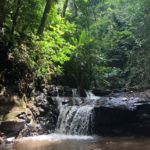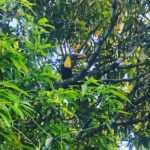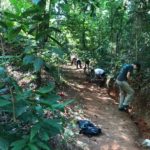Costa Rica’s rain forests make up 5% of the world’s biodiversity
Rain forests are a central part of Costa Rican culture and identity. It represents a symbiotic relationship between nature and man, which needs to be maintained and nurtured. Representing 5% of the world’s diversity, indeed, Costa Rica’s rain forests are a vital part of the natural world and must be protected against environmental and manmade threats.

International Forestry Day celebrated the world’s biodiversity and raises awareness about forests being home to some of the most incredible life on the planet, which in turn, acts as a platform to support our ever-growing human population.
Park rangers dedicate their careers to protecting and maintaining the vital areas which make up these wild and vast national parks.
A walk in La Cangreja National Park
Marvin Picado, one of the park rangers, shared his thoughts with us about the importance of forests in Costa Rica and its impact on the environment. He believes that reforestation is very important because it supports the equilibrium of the forest and the animals and plants that live within it.
He shared: “It’s very important to know about the native trees and plants, in order to support the natural ecosystem and the many species because planting trees which are not indigenous here may well harm the natural balance.”
La Cangreja is the only national park in Costa Rica that has a nursery for native plants. They maintain species in the nursery that are endemic and need protection. Marvin also shared an important point in that the nursery uses fertilizer and compost made from natural food and materials which cannot be recycled, for example, egg shells and cartons. He is very proud of this achievement.
Marvin is passionate about reforestation because he knows that the destruction of forests has a large effect on the environment. It impacts oxygen levels, global warming, desolation of habitat which kills birds, mammals and amphibians, and the loss of water sources, which in turn will affect humans in the long term. “The fauna and wildlife are codependent on the forest to live and thrive and it’s important to maintain the ecosystem, the cycle. For example, when an animal eats a piece of fruit, the seed will fall into the soil and grow new trees. This is an important cycle.
Some endemic animals at La Cangreja are –
- Mammals: Tepezcuintle, Venado cola blanca (Paca, White-tailed deer)
- Birds: Lapa roja, Gorza del sol (Red Macaw, Gorza del Sol)
- Reptiles: Terciopelo, Oropel (both venomous snakes)
- Amphibians: Rana verde (venomous green frog)
There are many different species of orchids and other flowers in the forest and they help maintain and supply life-giving oxygen to insects, amphibians and other animals. In the national park there are no endemic plants because it is a secondary forest. La Cangreja was established as a protected zone in 1986 and a national park in 2002.
Raleigh’s international volunteers spend months in Costa Rica helping the rangers at La Cangreja National Park to maintain and build new trails, and to dig trenches so that heavy rainfall can be channeled safely away from the paths. Efforts are ongoing to protect the sanctuary for flora and fauna not only to help protect the forest and its habitats, but to keep the park as an important place for tourism and education for national and international tourists.
Story by Jossette Selva Sanchez & Molly Taylor, Alpha 4 Expedition 19C
Edited by Karen Flynn
Los bosques tropicales de Costa Rica conforman el 5% de la biodiversidad del mundo: ¡lo que hacemos aquí importa!
Los bosques lluviosos son una parte central de la cultura y la identidad costarricenses. Representan una relación simbiótica entre la naturaleza y el ser humano, que necesita ser mantenida y nutrida. Representando el 5% de la diversidad del planeta, las de selvas tropicales de Costa Rica son una parte vital del mundo natural, y deben protegerse contra las amenazas tanto naturales como las causadas por las personas.
El Día Internacional de los bosques celebra la biodiversidad del mundo y crea conciencia sobre los bosques los cuales además de ser el hogar de algunas de las especies más increíbles del planeta, a su vez actúan como una plataforma para soportar nuestra creciente población humana.
Los guardabosques se dedican a proteger y mantener las áreas vitales que conforman estos salvajes y extensos parques nacionales.
Un paseo en el Parque Nacional de la Cangreja
Marvin picado, uno de los guardaparques, nos compartió su opinión sobre la importancia de los bosques en Costa Rica y su impacto en el ambiente. Considera que la reforestación es muy importante porque apoya el equilibrio del bosque, los animales y las plantas que viven allí.
Él compartió: “es muy importante saber acerca de los árboles y plantas nativas, con el fin de apoyar el ecosistema natural y las muchas especies porque la plantación de árboles que no son de aquí puede perjudicar el equilibrio natural”.
La Cangreja es el único parque nacional en Costa Rica que tiene un vivero para plantas nativas. Mantienen especies en el vivero que son endémicas y necesitan protección. Marvin también compartió un punto importante sobre que el vivero utiliza fertilizantes y compostaje hechos de alimentos naturales y materiales que no pueden ser reciclados, por ejemplo, conchas de huevo y cajas de cartón. Está muy orgulloso de este logro.
Marvin es un apasionado de la reforestación porque sabe que la destrucción de los bosques tiene un gran impacto negativo en el ambiente; afecta los niveles de oxígeno, el calentamiento global, la desolación del hábitat que mata a las aves, los mamíferos y los anfibios, y la pérdida de fuentes de agua, que a su vez afectará a los seres humanos a largo plazo. “La fauna y la vida silvestre son codependientes en el bosque para vivir y prosperar, y es importante mantener el ecosistema. Por ejemplo, cuando un animal come un pedazo de fruta, la semilla caerá en el suelo y hará crecer árboles nuevos. Este es un ciclo importante.
Algunos animales endémicos de la Cangreja son –
– Mamíferos: Tepezcuintle, venado cola blanca
– Pájaros: Lapa roja, garza del sol
– Reptiles: Terciopelo, oropel (ambas serpientes venenosas)
– Anfibios: Rana verde (venenosa)
Hay muchas especies diferentes de orquídeas y otras flores en el bosque que ayudan a mantener y suministrar el oxígeno que da vida a insectos, anfibios y otros animales. En el Parque nacional no hay plantas endémicas porque es un bosque secundario. La Cangreja fue establecida como una zona protegida en 1986 y como parque nacional en 2002.
Los y las voluntarias internacionales de Raleigh pasan meses en Costa Rica ayudando a los guardabosques del Parque Nacional La Cangreja a mantener y construir nuevos senderos, y a cavar zanjas para que las fuertes lluvias puedan canalizarse de manera segura lejos de los caminos. Se están realizando esfuerzos para proteger este santuario de flora y fauna no sólo para ayudar a proteger el bosque y sus hábitats, sino para mantener el parque como un lugar importante para el turismo y la educación para locales y extranjeros.





